30+ Memorable Event Badge Ideas: The Complete Guide for 2025
Whether you’re organizing a conference, trade show, or networking event, well-designed event badges make it easier for attendees to connect, find their way around, and engage with exhibitors and speakers easily. When badges are poorly designed, interactions feel awkward, and opportunities slip away. However, the right event badge choices ensure attendees can quickly find key information, spark conversations, and make meaningful connections.
This complete guide covers event badge ideas, essential layout strategies, proven best practices, and guidance on material choices so you can make a great first impression and help attendees connect.
Why Is Event Badge Design Important?
A well-designed badge isn’t just a formality; it plays a crucial role in how attendees experience your event. The best designs will help different attendee types achieve their event objectives. Every choice, from typography to color coding, affects how attendees interact with one another and engage with your programming.
Strategic event badge design solves the following common event challenges:
- Helping Attendees Identify Key Stakeholders: Badges with clear, bold text and role-based color coding make it easier for attendees to recognize speakers, sponsors, and exhibitors at a glance. This encourages more meaningful interactions and helps the right people connect effortlessly.
- Facilitating Conversations and Networking: A well-designed badge includes relevant details like company names, job titles, and QR codes for digital connections. These elements make introductions smoother and help attendees find common ground, making networking more organic and valuable.
- Improving Event Navigation and Session Attendance: Incorporating visual cues such as track labels, agenda highlights, or scannable session access indicators can help attendees easily navigate to the right areas. When badges provide useful information beyond just a name, they become a functional tool for supporting your event flow.
When event badge design elements work together, badges do more than identify attendees; they actively support engagement objectives and a smooth event flow.
Elements of Proper Event Badge Design
When designing your event badges, there are a couple of considerations to keep in mind. Let’s review the main elements your badges should include and tips for implementing them effectively.
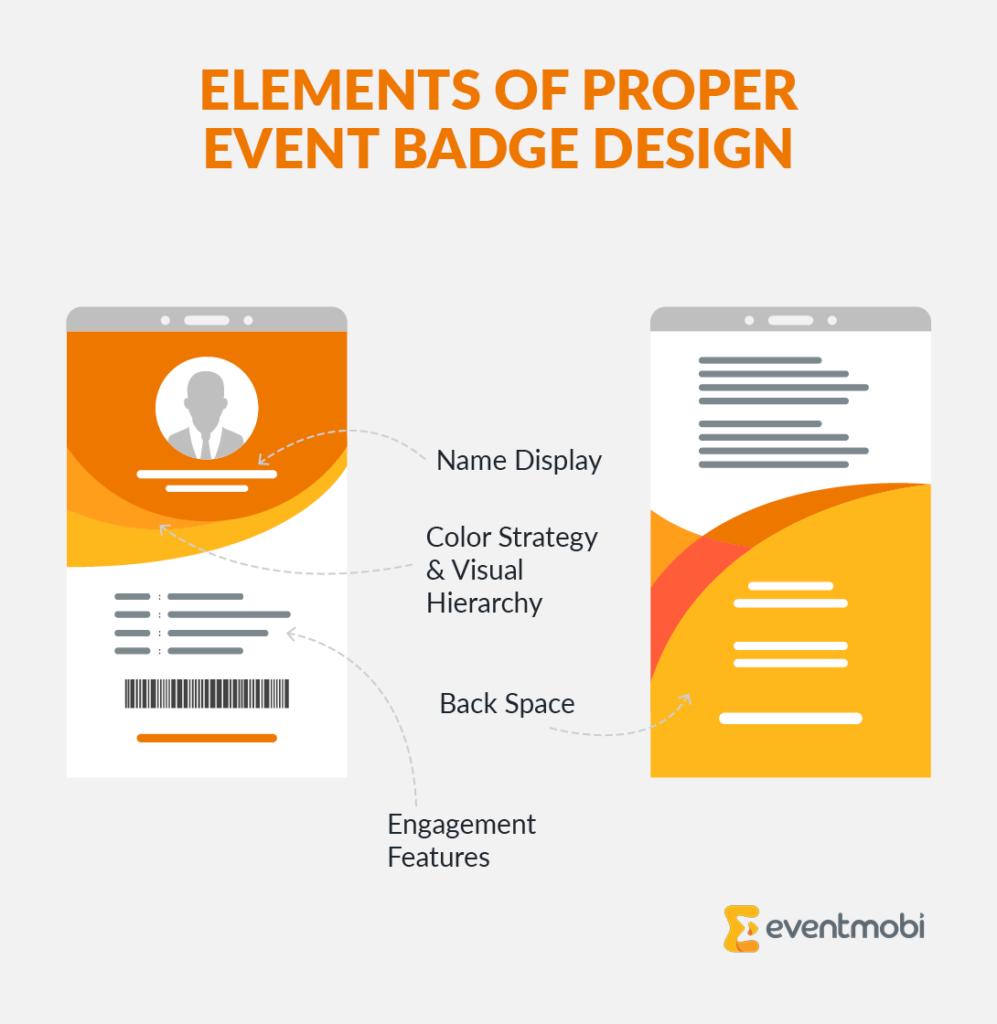
Name Display Guidelines
Your event badge design starts with the most important element: the attendee’s name. Typography makes or breaks readability, so font choices and sizing are critical. First names should be visible from 6-8 feet away, using sans-serif fonts like Arial or Helvetica for maximum legibility. To ensure readability, use the following font sizes for name display:
- First names: 24-36 pt font size
- Last names: 18-24 pt font size
- Company names: 16-20 pt font size
- Titles: 14-18 pt font size
Test your designs with both short and long names to maintain readability and a professional appearance. For instance, what works for an attendee named “Bob Smith” should also work for an attendee named “Christine Montgomery-Fitzgerald.”
Color Strategy & Visual Hierarchy
Color makes badges intuitive navigation tools. A well-planned color system helps attendees instantly recognize different tracks, access levels, or roles. However, restraint is key; stick to 4-5 colors to avoid confusion.
Additionally, follow these tips to choose effective badge colors:
- Use high-contrast colors for better readability.
- Keep colors consistent across all event materials.
- Add patterns or icons in addition to color so attendees with color vision deficiency can still tell the difference.
- Match colors to your event or organization’s branding for visual cohesion.
The most important details should stand out immediately, while secondary information remains visible but subtle. This natural hierarchy helps attendees process information quickly, especially in fast-paced networking environments.
Using Badge Back Space
The back of the badge is often overlooked, but it’s valuable event badge real estate. It can serve as an attendee guide by providing quick access to key information or links to digital resources. Smart ways to use the badge back include:
- Add a venue map with key locations marked.
- Offer emergency contacts and help desk information.
- Display Wi-Fi network details to save attendees time.
Link to event resources with a QR code—ideal for FAQs, session guides, or sponsor materials.
QR codes can link to any online resource, so get creative! However, personalize links by attendee type (not individual attendees) for bulk badge production. Use a QR code generator, and then upload the codes into your badge design tool. → IMPORT A LIST – THERE IS A FIELD FOR CHECK-IN CODE – ADD
Turn attendee QR codes into networking tools by replacing their default check-in code with a link to their social profile, like LinkedIn. Here’s how:
- Collect Data – Add a registration field to capture attendees’ social profile link during sign-up.
- Export Data – Download the list of confirmed registrants and their details.
- Update QR Codes – Copy the social profile links into the “Check-In Code” field.
- Import & Apply – Upload the updated list to apply the changes.
Now, each attendee who shared their social link will have a badge QR code that works for both event check-in via the Onsite App and networking using a QR code reader from a smartphone.
Engagement Features
Badges can do more than display names; they can spark conversations and encourage participation. Here’s how to make them more interactive:
- Add gamification elements: Hide challenge codes on event badges and provide fun stickers and badge ribbons to reward participation in scavenger hunts or interactive sessions.
- Provide conversation starters: Add icebreaker prompts, industry topics, or interests to help attendees connect naturally.
- Make networking easier: Add a QR code that instantly directs attendees to a LinkedIn profile when scanned with a smartphone QR code reader.
- Incorporate interactive elements: Try scratch-off badges to reveal fun challenges, prize opportunities, or exclusive event perks. Some custom badge printing companies offer this feature—just ask when ordering.
Track how well your event badges spark active participation by evaluating engagement metrics and surveying attendees about how these event badge ideas added value to their event experience.
Event Badge Materials: What Works for Different Event Types
The right materials make badges both durable and functional. While unique options might catch your eye, they often cause printing problems and delays. Stick with materials that ensure clear printing and withstand the demands of a busy event.
Explore the best badge materials by event type:
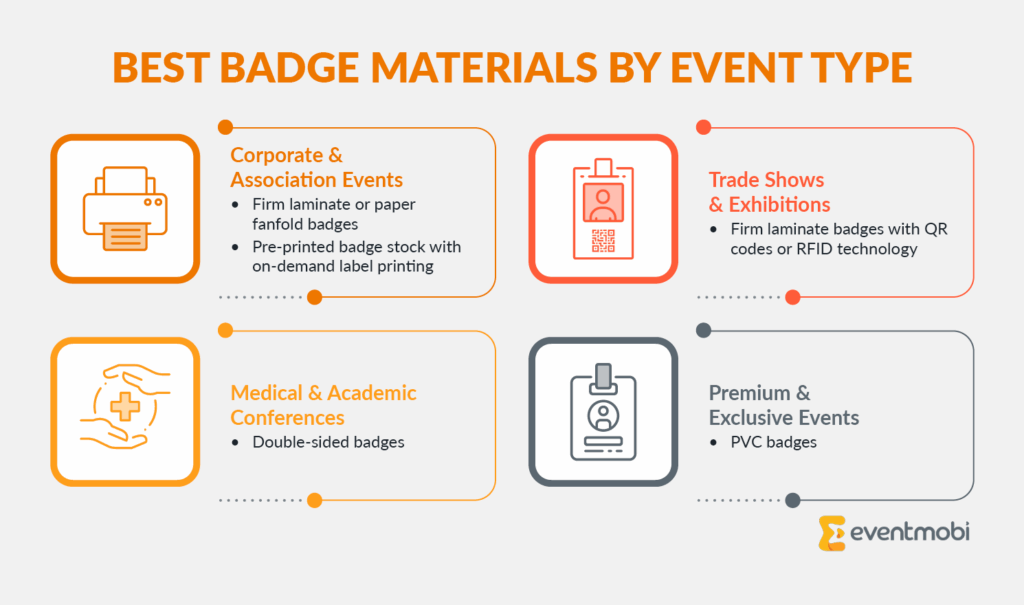
- Corporate & Association Events: Firm laminate or paper fanfold badges provide a professional look and hold up well throughout multi-day events. Using pre-printed badge stock with on-demand label printing allows for efficient handling of last-minute changes without sacrificing quality.
- Trade Shows & Exhibitions: Exhibitor badges must be durable and easy to scan. Firm laminate badges with QR codes or RFID technology support easy lead capture and exhibitor interactions while maintaining a polished appearance.
- Medical & Academic Conferences: These events require badges that clearly display specialties, certification levels, and QR codes for session check-ins and CME tracking. Double-sided badges can include general event schedules and key learning resources relevant to all attendees.
- Premium & Exclusive Events: For award ceremonies, VIP programs, and high-end networking events, PVC badges provide a polished, high-quality finish while remaining durable. These are ideal for showcasing VIP access and sponsor branding while keeping production practical and scalable.
31 Professional Event Badge Ideas
Your event goals shape your badge design choices. Here are battle-tested event badge ideas for different professional events:
Corporate Event Badge Ideas
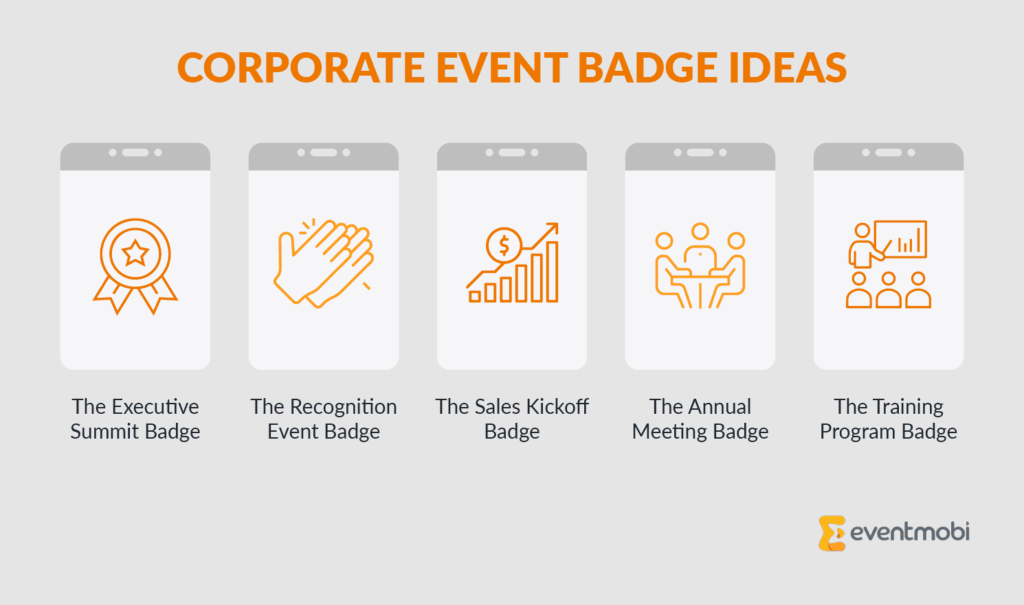
1. The Executive Summit Badge
Foster networking opportunities by displaying detailed attendee information on the front. Add a conversation starter to drive interactions. On the back, provide a QR code linking to speaker bios, post-event surveys, or key resources for continued engagement.
2. The Recognition Event Badge
Celebrate achievements by featuring attendee details and their award category prominently on the front. On the back, provide information about exclusive receptions and key honoree events happening throughout the venue.
3. The Sales Kickoff Badge
Unite sales teams with territory and team identifiers on the front. Add a scratch-off area on the back to reveal team competition details and challenge information, or incorporate a QR code to offer quick access to sales enablement materials.
4. The Annual Meeting Badge
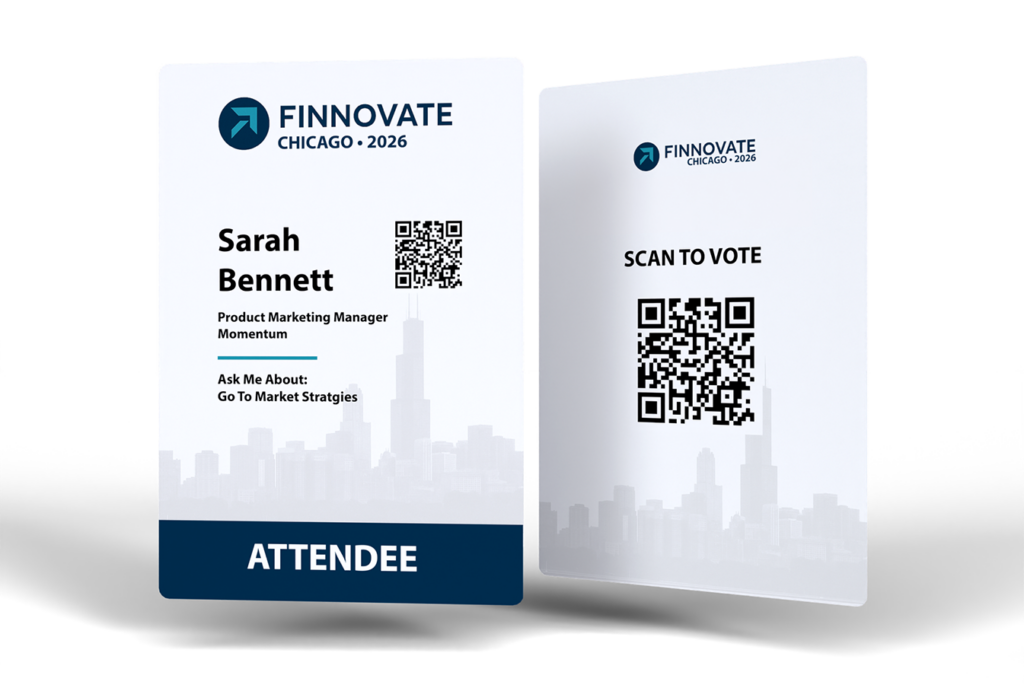
Simplify participation by displaying attendee meeting roles on the front. On the back, include a QR code directing attendees to voting platforms, proxy assignment details, or key governance documents.
5. The Training Program Badge
Encourage professional development by listing certification levels and learning tracks. On the back, include a QR code linking to session slides, key learning materials, or a resource hub for further education.
Association Event Badge Ideas
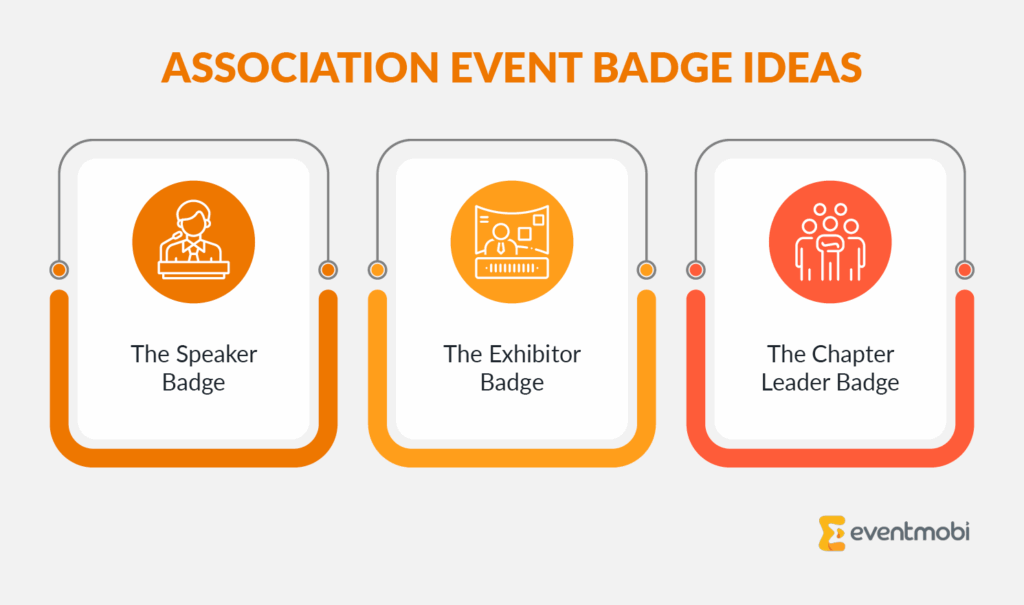
6. The Speaker Badge
Help speakers promote their sessions by displaying “Ask me about…” below their name on the front, along with session titles and room numbers. On the back, add technical setup checklists and AV team contacts to ensure stress-free presentations.
7. The Exhibitor Badge
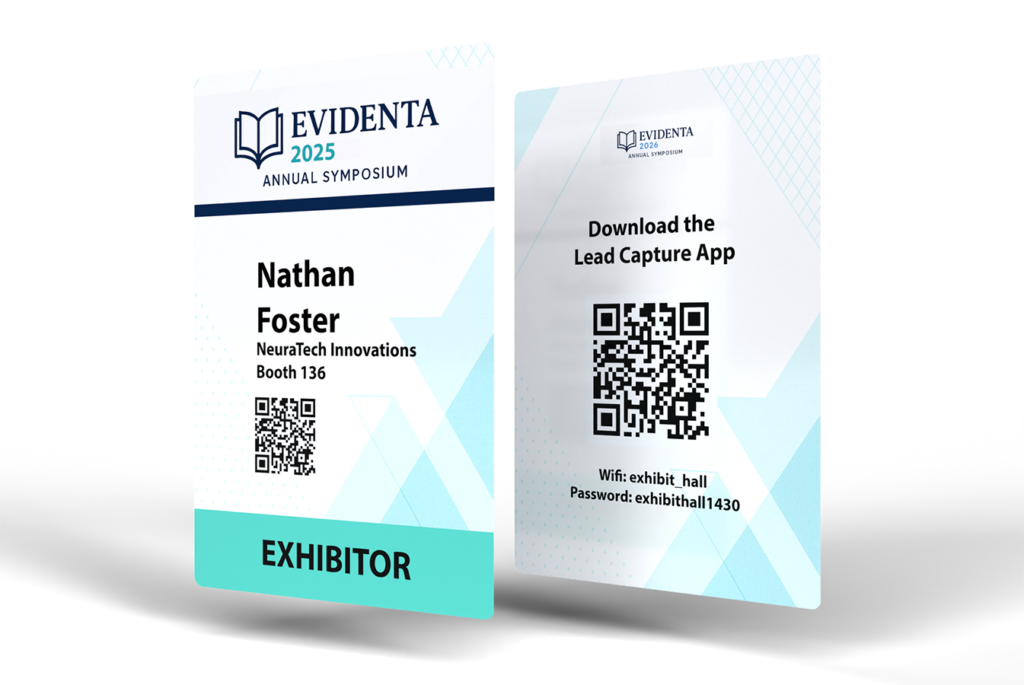
Drive engagement with event exhibitors by highlighting the sponsor company’s name, logo, and booth location on the front. Adding key information on the back, like Wi-Fi details or download details for the lead capture system, will save both organizers and exhibitors valuable time.
8. The Chapter Leader Badge
Identify leaders by including their chapter names and roles on the front. On the back, include a QR code linking to key resources like chapter management guidelines, leadership meetups, policy updates, and direct contact details for association support staff.
Medical & Academic Event Badge Ideas
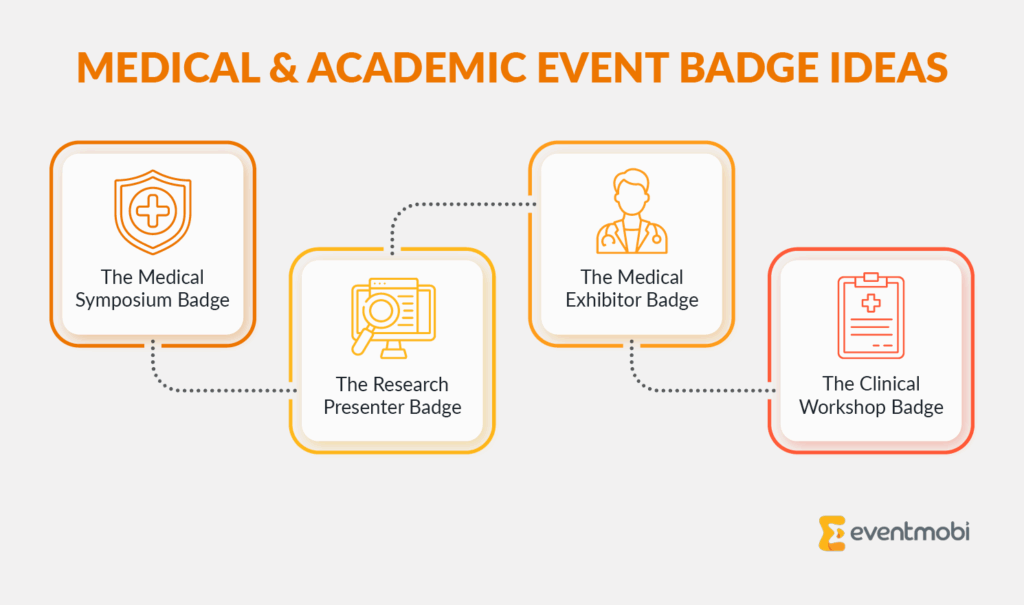
9. The Medical Symposium Badge
On the front, display attendee details, including specialty and certification level, and a QR code for session check-ins and CME tracking. On the back, include CME credit claim instructions, session evaluation deadlines, or a link to a shared repository with session handouts and speaker slides.
10. The Research Presenter Badge
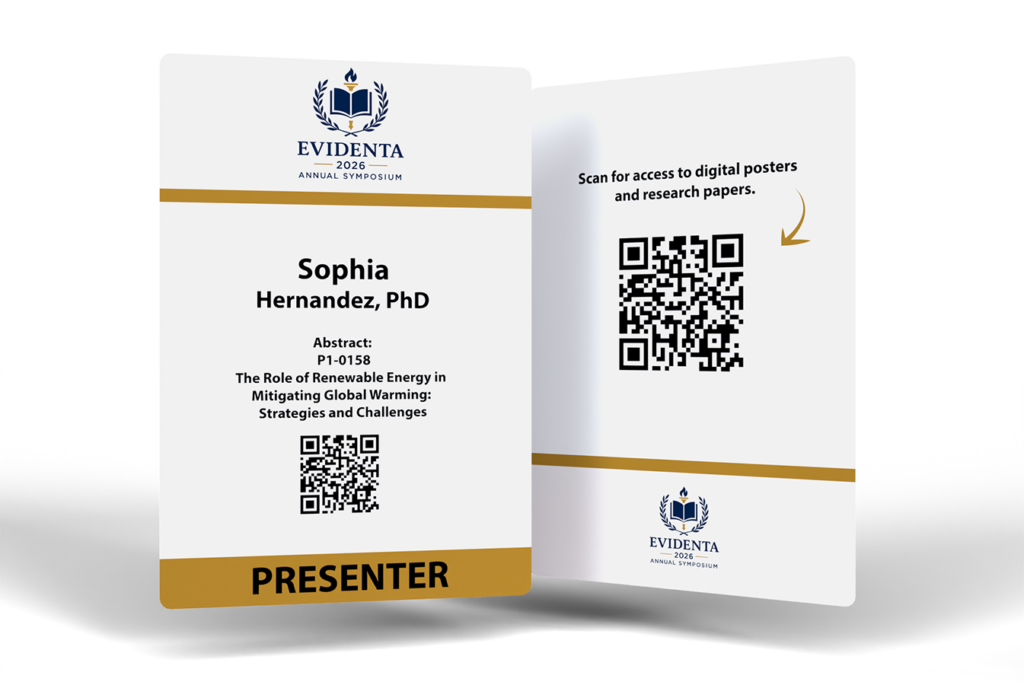
Help presenters connect with attendees by featuring their names, abstract numbers, and presentation details on the front. On the back, include a QR code linking to digital posters, research papers, or group discussion forums for continued engagement beyond the session.
11. The Medical Exhibitor Badge
Increase exhibitor visibility by featuring company name, logo, booth location, and specialty focus on the front. On the back, include a QR code linking to exhibitor services like lead retrieval support, order forms, shipping details, and venue contacts.
12. The Clinical Workshop Badge
Highlight attendees’ expertise by displaying specialties and training levels on the front. On the back, include procedural checklists, essential learning objectives, and instructor contact details to ensure participants have quick access to key training resources.
Professional Development Event Badge Ideas
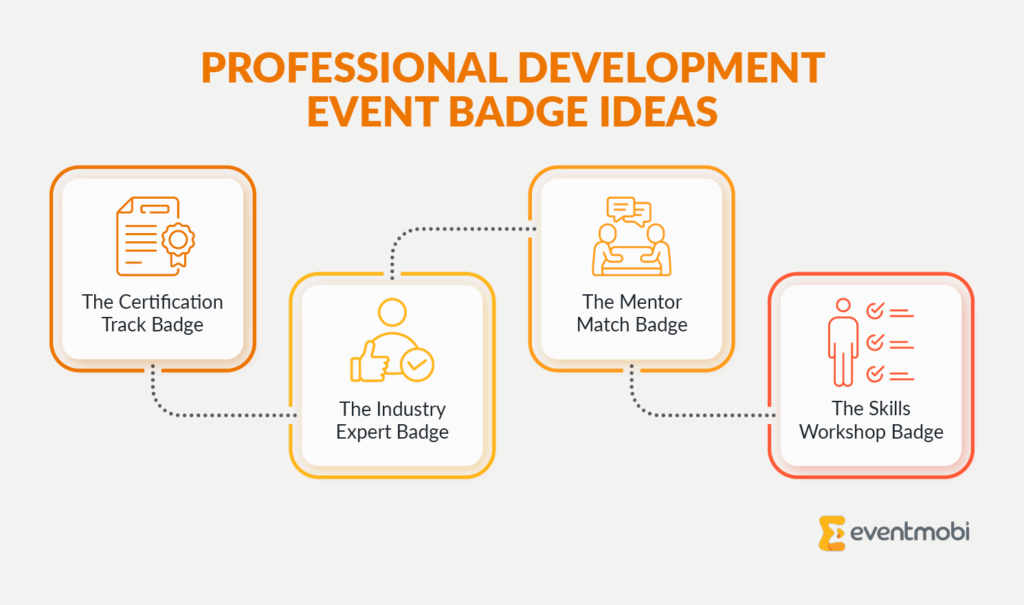
13. The Certification Track Badge
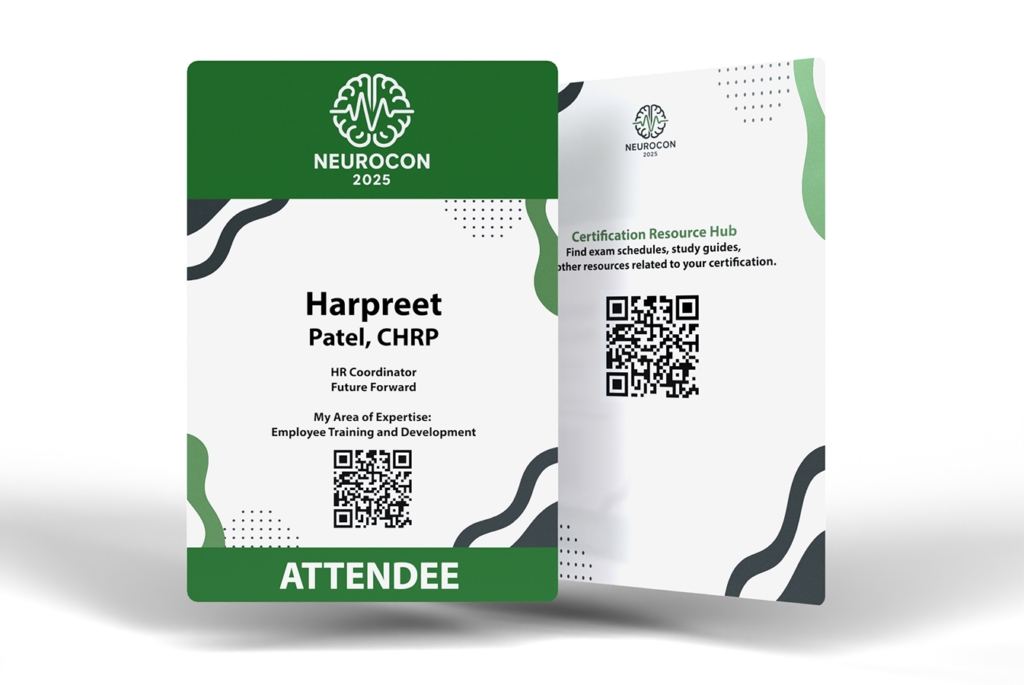
Showcase attendee certification status and area of expertise. On the back, provide a QR code linking to a certification resource hub with study guides, exam schedules, and continuing education materials to help attendees track their progress.
14. The Industry Expert Badge
Spotlight expertise by listing the attendee’s specialty and notable contributions along with their details. On the back, link to industry reports, keynote materials, or expert roundtable schedules to facilitate meaningful professional discussions.
15. The Mentor Match Badge
Clearly distinguish mentors and mentees with role indicators on the front. On the back, include structured networking prompts and a note-taking template when printed on firm laminate or PVC badges, allowing for easy annotations with a washable marker.
16. The Skills Workshop Badge
Indicate skill levels and training tracks on the front. Include session information, equipment access details, and instructor contact information on the back to support hands-on learning and technical skill development.
Networking Event Badge Ideas
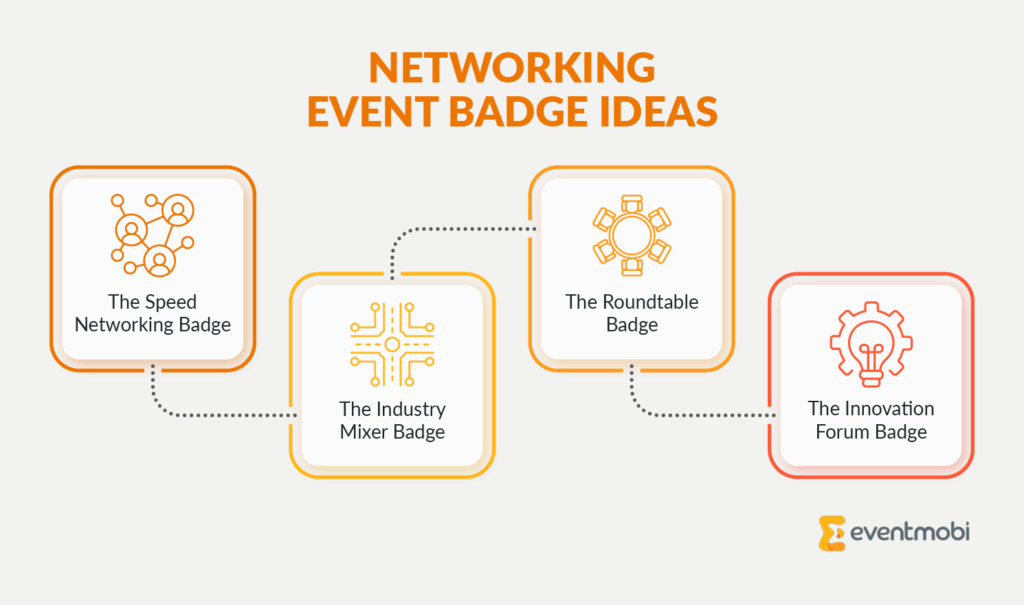
17. The Speed Networking Badge
Encourage quick connections by listing attendee details and interests on the badge front. On the back, include a rotation schedule, icebreaker prompts, and conversation starters to help attendees make the most of short networking sessions.
18. The Industry Mixer Badge
Facilitate networking by displaying sector and collaboration goals on the badge front. On the back, provide key networking event details, themed discussion zones, and meetup locations to help attendees easily form valuable connections.
19. The Roundtable Badge

Support discussions by listing an attendee’s topic of expertise on the front. Include table assignments and a QR code linking to relevant session materials or discussion guides on the back to encourage informed and structured participation.
20. The Innovation Forum Badge
Highlight attendee expertise by displaying project focus or technical specialty on the front. On the back, include a QR code linking to an online repository with pitch decks, product roadmaps, or key research findings to foster collaboration and investor interest.
Special Event Badge Ideas
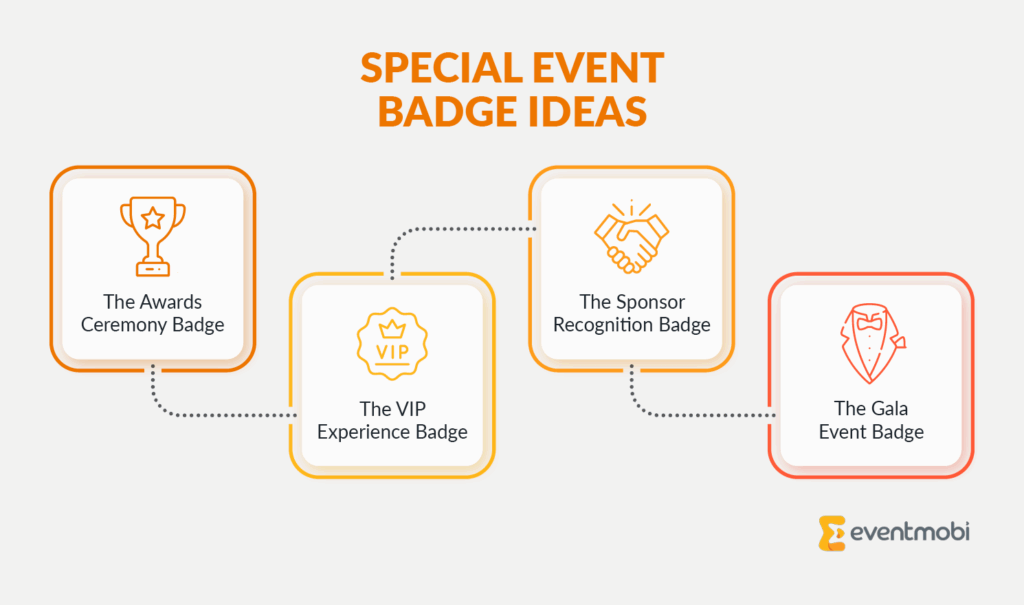
21. The Awards Ceremony Badge
Honor achievements by featuring award categories and honoree names prominently on the front. Include the ceremony schedule, photo session times, and special seating arrangements on the badge back to ensure a smooth experience for awardees and guests.
22. The VIP Experience Badge
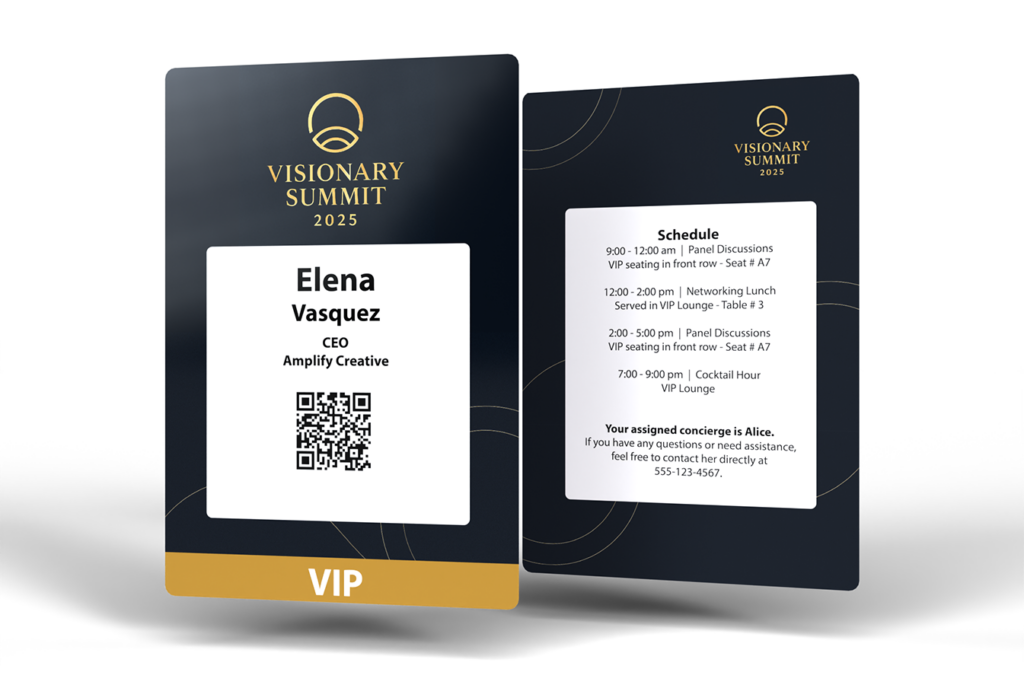
Highlight VIP status by showing access levels on the front of the badge. On the back, include a personalized VIP schedule, lounge locations, and a direct concierge contact to offer a premium event experience for these attendees.
23. The Sponsor Recognition Badge
Acknowledge sponsors with tier levels on the front. On the badge back, provide details on networking event access, key exhibitor benefits, and contact information for support services to ensure they can make the most of their investment.
24. The Gala Event Badge
Welcome guests by featuring their names and table assignments on the front. Provide the evening’s schedule, key event highlights, and donor recognition details on the back to help attendees navigate the night with ease.
Conference Management Event Badge Ideas
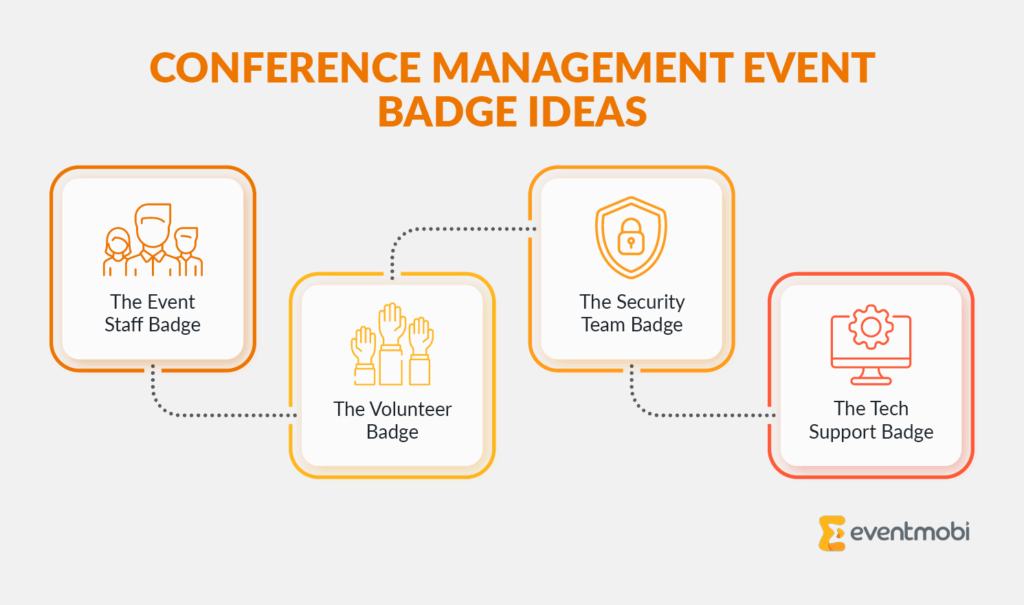
25. The Event Staff Badge
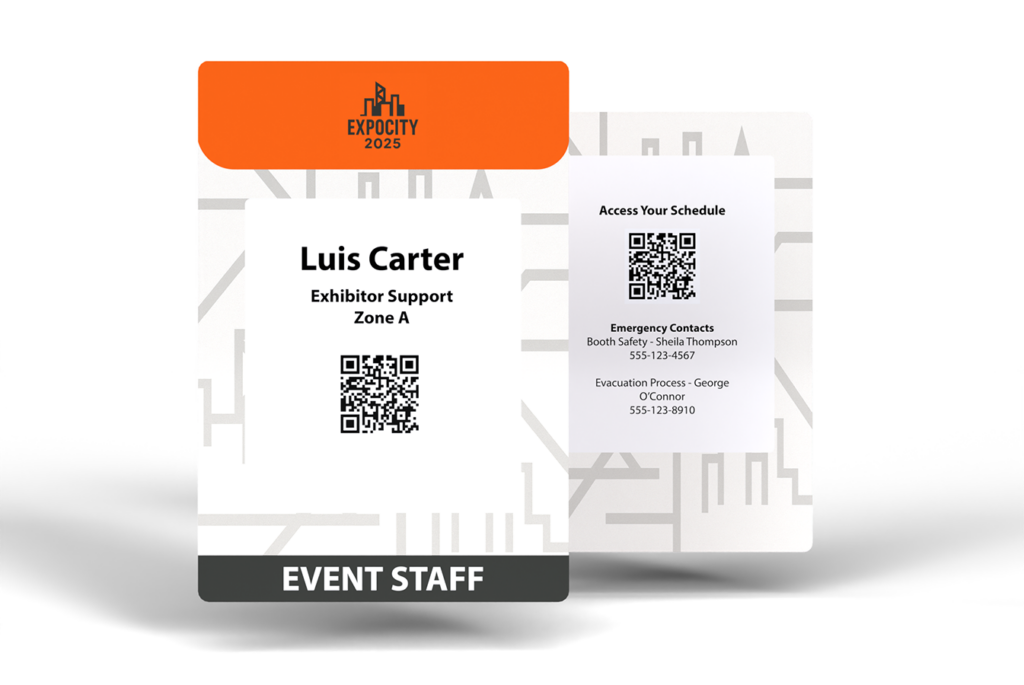
Ensure visibility by featuring roles and zone assignments on the front. On the back, link to shift schedules, and include emergency contacts and escalation procedures so staff can respond quickly to any event needs.
26. The Volunteer Badge
Clearly identify volunteers with roles and assigned areas on the front. On the back, add a QR code linking to volunteer schedules, task assignments, and a contact list for event organizers to provide support as needed.
27. The Security Team Badge
Mark security personnel with access levels and designated zones on the front. Include emergency response procedures, radio channels, and key contact information on the badge back to ensure efficient security coordination.
28. The Tech Support Badge
Clarify responsibilities by listing roles and service areas on the front. System access credentials and links to troubleshooting guides on the back of the badge will help support staff resolve issues quickly.
Multi-Day Event Badge Ideas
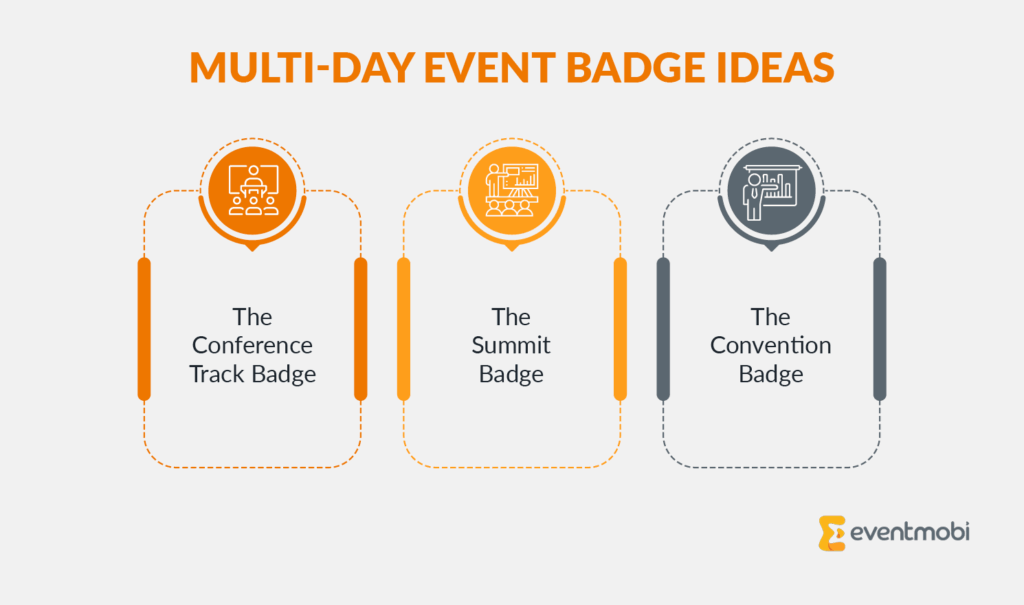
29. The Conference Track Badge
Guide attendees by featuring their selected tracks on the badge front. On the back, include a QR code linking to a track-specific agenda with session times, room locations, and speaker details to help attendees stay on schedule.
30. The Summit Badge
Control access by featuring clearance levels and attendee categories on the front. Provide key contact information for event support, a QR code for venue maps, and details on exclusive networking areas or VIP lounges on the badge back.
31. The Convention Badge
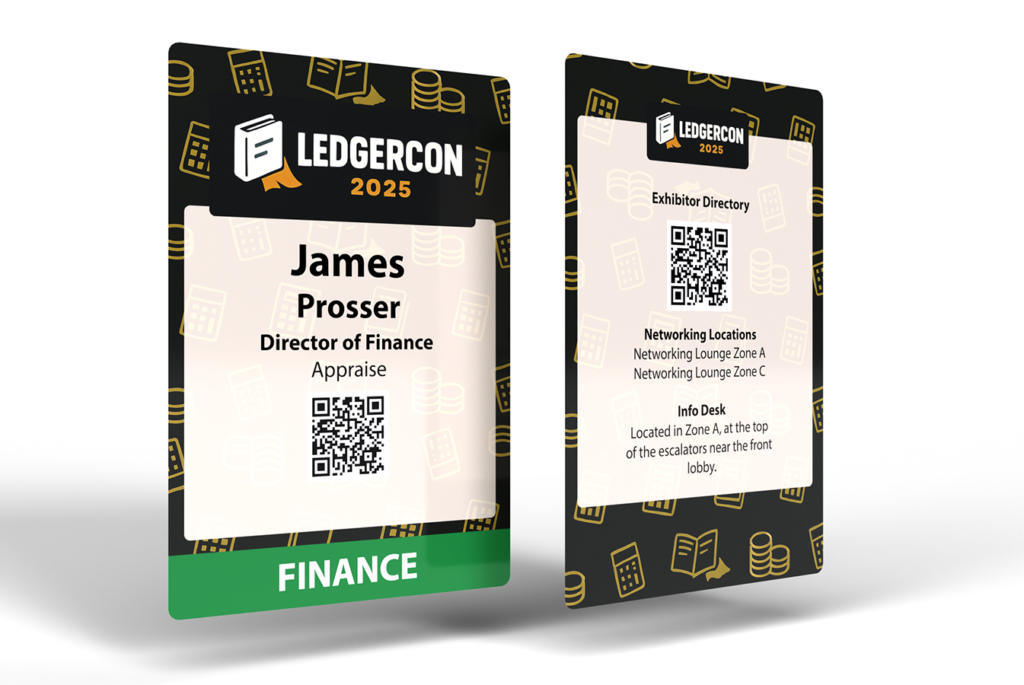
Show attendee industry and session track on the front. On the back, provide a QR code linking to the exhibitor directory, key networking locations, and important venue services like info desks, lounges, and transportation details.
Event Badge Production Guidelines
With a better idea of the event badge ideas, design, and materials you want to use, the next step is producing your badges. Timing matters when it comes to badge production. Start early enough to allow for adjustments, but remember that event details often evolve, so flexibility is key.
Consider these key badge production tips:
- Pre-print attendee badges for small events 1-2 weeks ahead of time to allow time for delivery and sorting by attendee type and name.
- Use badge label printing or live badge printing for events with last-minute registrations and walk-ins.
- Test badge designs with sample prints to ensure names, roles, and QR codes are clearly visible and scannable in different lighting conditions.
Event Badge FAQs
An event badge should include the attendee’s name, organization, and role. Additional helpful elements include QR codes for networking, session tracks, and access levels. The back can feature Wi-Fi passwords, venue maps, or other key event details.
The most practical event badge size is 4″ x 6″, which provides enough space for essential information while remaining readable. Small events may use 4″ x 3″ badges, while simple white badge labels work well for informal gatherings.
Use clear fonts, consistent branding, and high-quality materials like firm laminate, paper fanfold, or PVC badges. Keep the design uncluttered, prioritize name visibility, and use color coding for different attendee groups.
Print badges as close to your event as possible while allowing time for quality control. Pre-print for known attendees 1-2 weeks before the event, or choose onsite badge printing for events needing more flexibility.
Make badges networking-friendly by including conversation starters, interests, or industry roles. Add QR codes linking to professional profiles or digital business cards, and use color coding to help attendees identify similar interests.
Most events benefit from firm laminate or paper fanfold badges. PVC works well for premium events or those requiring extra durability. Pre-print badge stock and combine it with on-demand badge label printing to accommodate last-minute changes.
Want more help with the end-to-end badge creation process? Get detailed advice on how to effectively manage badge design, printing, and check-in at your next event in this step-by-step guide: Conference Badge Design: Create and Print in 7 Easy Steps.
Start Creating Professional Event Badges
Now that you’ve explored these event badge ideas, you’re ready to design your own. Think about your specific event needs and choose elements that will create the best experience for your attendees.
The right badge design tool makes all the difference. EventMobi’s Badge Designer is built for event professionals, making it easy to create professional badges without any graphic design experience. With customizable templates, built-in pre-printed badge ordering, and seamless integration with your registration system, you can generate badges that are accurate, visually appealing, and ready when you need them. Whether you’re pre-printing event badges or printing live onsite, EventMobi ensures a simple, efficient process from design to distribution.
EventMobi’s Badge Designer and flexible printing solutions make it simple to create and distribute professional event badges.